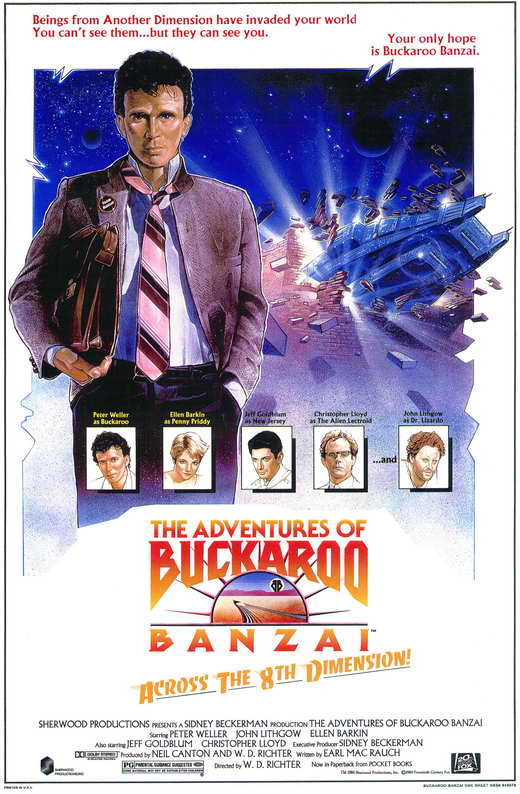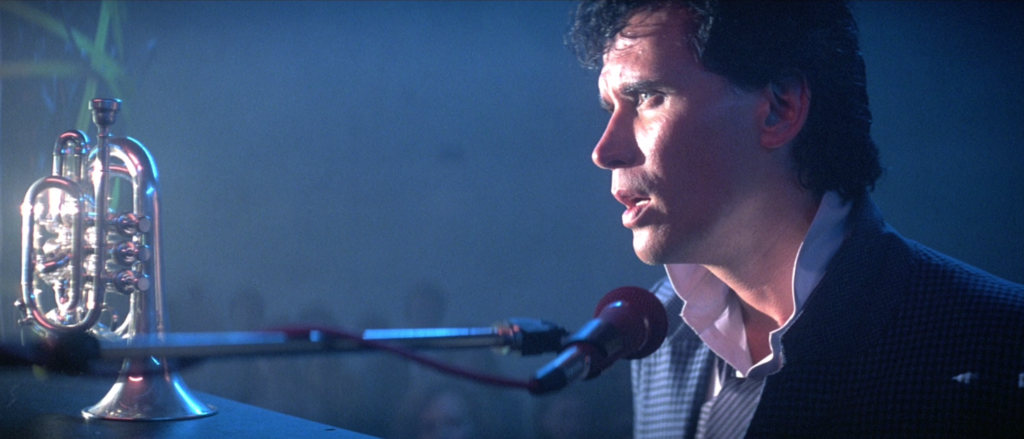
The Adventures of Buckaroo Banzai Across the 8th Dimension is a deeply strange blend of genres and styles, a film of raw imagination and improbable swagger that somehow escaped to theaters in 1984. Director W.D. Richter (who had written the 1978 Invasion of the Body Snatchers and would go on to write Big Trouble in Little China) tangled with the head of the production company, a man who believed a hero should never wear glasses (Buckaroo got to keep his, barely) and that the film shouldn’t look as good as Blade Runner (DP Jordan Cronenweth was inexplicably fired). Yet the end result is just as weird and cluttered as Richter and screenwriter Earl Mac Rauch (New York, New York) wanted it to be. Building upon the renewed interest in serialized pulp following Star Wars and Raiders of the Lost Ark – the trend was the only reason this film was greenlit in the first place – Buckaroo Banzai acts like the umpteenth chapter in an ongoing Doc Savage-style saga. Just before dropping us right into Banzai’s latest experiment to drive his jetcar through a mountain and into the 8th dimension, some scrolling text explains that he’s a brilliant, half-Japanese neurosurgeon, martial arts expert, particle physicist, and rock ‘n’ roller, always accompanied by his companions, the Hong Kong Cavaliers. That the whiter-than-white Peter Weller cannot possibly embody all these requirements is one of the film’s many droll jokes. Most of the time he doesn’t need to do much but stand there, look Zen, and say things like “Wherever you go…there you are.” Relaxed style and cool amidst the blatantly insane is what Buckaroo Banzai is all about. Most of the cast, be they human or alien, never receive proper introductions, but have a unique wardrobe and a memorable name. Therefore, watching the film is like crashing a party where you don’t know anyone there. The party goes on with or without you; the film knows it will find the ones who “get it.” And if you’re indifferent, well, one of the Black Lectroids makes the film’s position clear when he closes Buckaroo Banzai with, “So what? Who cares?”
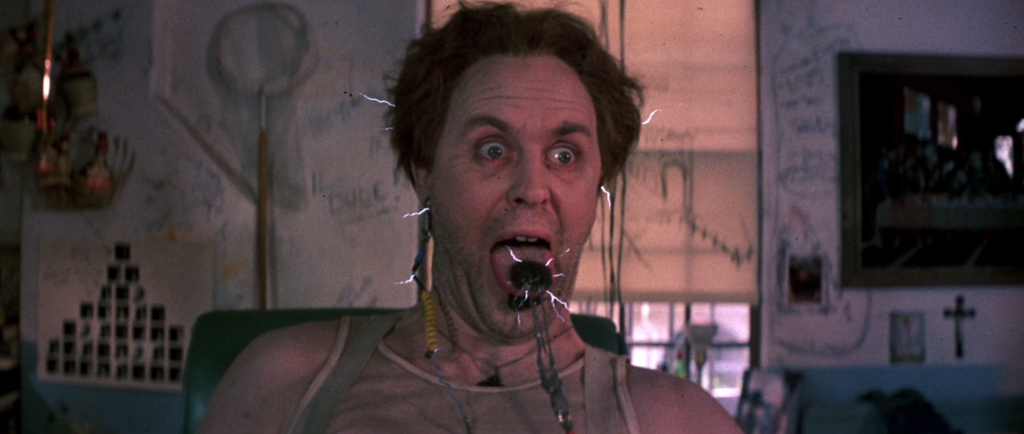
Dr. Emilio Lizardo/Lord John Whorfin (John Lithgow) gets an electric fix.
All this is to say that the film was a big flop at the box office, and found its audience over home video and TV airings. I did see it in the theater, though I was 8 and the story was incomprehensible to me. I caught up with it on VHS when I was a teenager, and the story was still incomprehensible to me. Now I can watch it and follow the story more or less, which is not to say that the story is told particularly well. I’m not sure how much that matters; I mean, it does, but I’m not sure how much. This is a film of characters and moments. My favorite scene, the introduction of Ellen Barkin’s Penny Priddy, is stylistically divorced from anything else in the movie. In a nightclub of blue neon lights, Buckaroo Banzai and the Hong Kong Cavaliers, with a generous sax section, are rocking an instrumental on the stage. Then Banzai interrupts the act because he hears (somehow) a woman crying – much to consternation of the handsome Cavalier named Perfect Tommy (a very funny Lewis Smith). Banzai, in a somewhat insensitive moment of sensitivity, asks that a spotlight be turned on the woman in the audience: Penny, mascara running, who confesses to the awful day she’s had, unaware that she had a twin sister who was once Banzai’s lover before she died but-never-mind-the-film-will-get-to-that-later. Banzai pays tribute by sitting at the piano and crooning “Since I Don’t Have You,” a romantic moment undercut not just by the onstage dialogue (Perfect Tommy is still grousing) but by the sight of Penny pointing a gun at her head. An oblivious waitress accidentally knocks the gun away just as it’s fired, and all the Hong Kong Cavaliers onstage immediately pull guns on the audience. After this, it’s hard for Banzai to get any better. But this movie also has Jeff Goldblum.
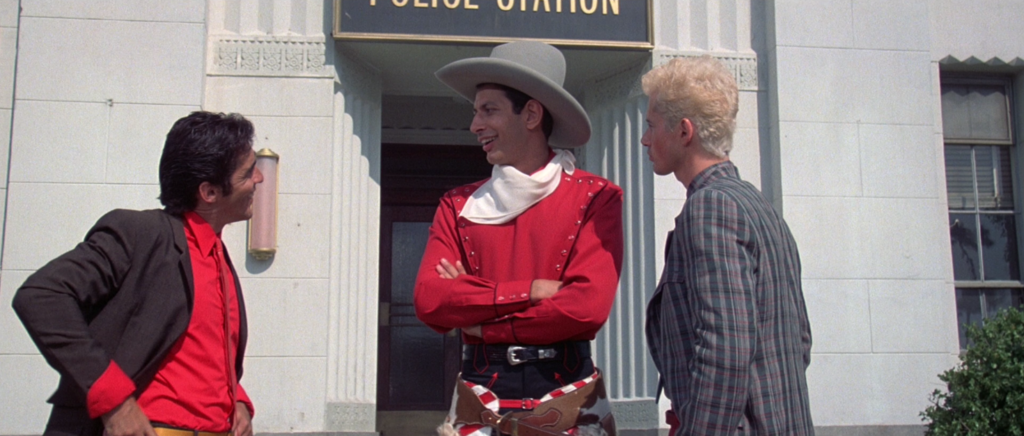
New Jersey (Jeff Goldblum) introduces himself to Reno Nevada (Pepe Serna) and Perfect Tommy (Lewis Smith).
Goldblum’s character, a surgeon named New Jersey, is perhaps as close as the story comes to providing an audience surrogate; after all, he joins the gang through the course of the story, has to earn the Cavaliers’ trust, and goes goggle-eyed when he sees one of the extraterrestrials shed its human skin (no one else reacts). But he’s also very familiar with Buckaroo Banzai, being an avid reader of the Buckaroo Banzai in-universe comic books. He dresses as a cowboy because he thinks it’s going to be that kind of adventure. “Congratulations!” he greets his hero. “You drove through a mountain!” Soon he’s riding along with Banzai in his tour bus, which is actually crammed with computers and gizmos to assist the Cavalier’s investigations. The latest involves a rock retrieved from the 8th dimension which has made them the target of the evil Red Lectroids, all of whom are named John and have chosen from the most interesting faces of our planet’s character actors: Christopher Lloyd, Vincent Schiavelli, Dan Hedaya, and John Lithgow. Lithgow is actually an Italian physicist, Dr. Lizardo, whose transdimensional experiments left him possessed by the Red Lectroid leader John Whorfin, a being leading his race on a breakout from the 8th dimension. They were banished there by their enemies the Black Lectroids, who are played by black actors: Doctor Sleep‘s Carl Lumbly, as a Rastafarian, and The Omega Man‘s Rosalind Cash. Meanwhile, the Secretary of Defense (Matt Clark) teams up with Banzai’s group to investigate the Red Lectroid infiltration of a defense contractor. See? Not that incomprehensible after all.
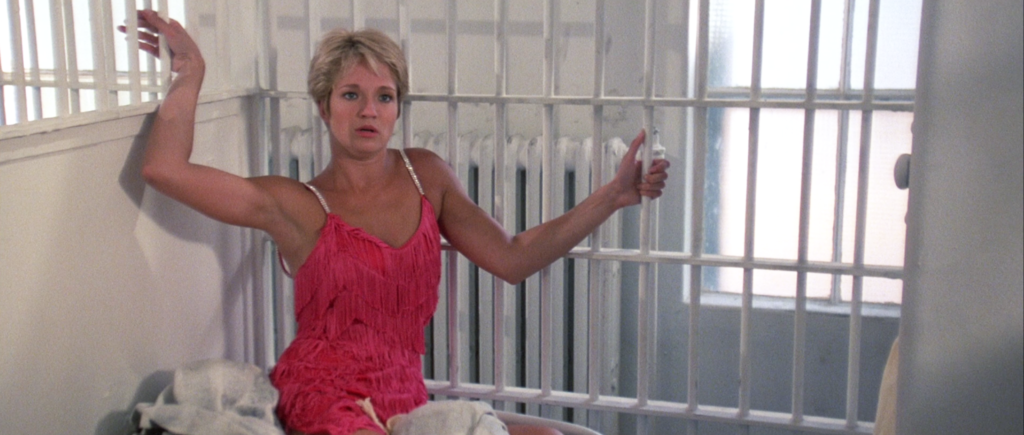
Ellen Barkin as Penny Priddy.
The Lithgow scenes, in which he slowly becomes more and more like Mussolini and keeps mispronouncing the last name of Red Lectroid John Bigbooté (Lloyd), encapsulate Richter’s directorial approach to Banzai: cram the film with talent, let everyone do their thing, and no half-measures. The actors, almost all of them ringers, clash pleasingly. Even a pre-Breaking Bad Jonathan Banks is here, as one of Lithgow’s security guards at the asylum. No one, with the exception of Lithgow, can get quite enough screen time, which perhaps might help explain the famous ending credits, in which we get to watch all of the good guys, living and dead, walk/dance/strut through the concrete culvert of the Los Angeles Sepulveda Dam. (Wes Anderson later paid homage to this in another movie featuring Goldblum, The Life Aquatic with Steve Zissou.) Something might seem to be missing, particularly on early viewings. The plot, for all its frenetic moments, can seem inert, many of the characters just types. But like Terry Gilliam’s films, there is so much detail that on each revisit you’ll probably notice some new delightful prop or bit of non sequitur dialogue, or come up with new questions to ask, like “Why is Vincent Schiavelli pouring honey on Ellen Barkin’s arm?” or “What is that watermelon doing in that machine?” And it is endlessly quotable (“Laugh while you can, monkey-boy”). “Cult film” gets thrown around a lot, but Buckaroo Banzai helps define the term. Each time you watch, the enigmatic coolness begins to slip away, and the innocent goofiness becomes more obvious. You can only crash a party once, after all, and Banzai gets more welcoming as it ages.
